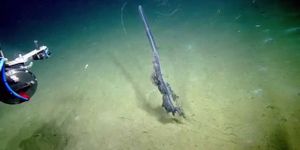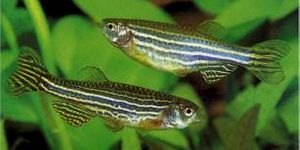Videos
Stunning Siphonophore
SEP 25, 2014 12:00 AM PDT
Share
Should We Let Half the World Go Wild?
 There have been five "mass extinctions" on Earth. These are periods when extremely large numbers of species go extinct. Today 99.9 percent of all the species that have existed on Earth are extinct. There are scientists that believe we may be in the beginning stages of a sixth mass extinction. Understanding past extinctions may help put the next one into perspective.
There have been five "mass extinctions" on Earth. These are periods when extremely large numbers of species go extinct. Today 99.9 percent of all the species that have existed on Earth are extinct. There are scientists that believe we may be in the beginning stages of a sixth mass extinction. Understanding past extinctions may help put the next one into perspective.The first mass extinction took place about 239 million years ago during the Ordovician-Silurian era. It may have encompassed two distinct extinction times separated by hundreds of thousands of years. During this time, when most life was in the sea, 25 percent of marine families and 60% of marine genera (the classification above species) were lost.
The next extinction, around 364 million years ago is known as the Late Devonian. Three quarters of all species on the planet died out. Its exact cause is unknown, but it may have been a series of extinctions over millions of years, rather than one event.
The Permian-Triassic extinction, occurring about 251 million years ago was the worst. A staggering 96 percent of all species died out. All life on Earth today is descended from the 4% that survived.
About 199 to 214 million years ago the End Triassic extinction took place, wiping out 22 percent of marine families, 52% of marine genera and an unknown percentage of vertebrate deaths resulted.
Finally, the Cretaceous-Tertiary extinction came about roughly 65 million years ago. It's best known for causing the extinction of the dinosaurs, but many other life forms were wiped out, including 16 percent of marine families, 47% of marine genera and 18 percent of land vertebrates, which included the dinosaurs.
How can we stave off a sixth mass extinction? Previous extinctions are thought to be caused by natural events, such as asteroid impacts, volcanic activity and climate change. Unlike those, scientists think the sixth may be caused by human activity which is isolating ecosystems. E.O. Wilson, the renowned Harvard biologist believes we have to set aside half the world solely for the use of wildlife. Known as the "Half Earth" theory, half the world would be for us, and half would be for them. This idea builds upon Wilson's widely accepted theory of island biogeography which explains why isolated ecosystems such as those of an island or national park inevitably lose species resulting in a decrease of biodiversity. There are several reasons for this. In small areas without ‘bridges' to connect them to similar habitats, species are more likely to become extinct. This is partly because wildlife need to draw from a broad gene pool to avoid the harmful "genetic anomalies" which often result when breeding with relatives. Also, isolated populations are more vulnerable to disease, over-hunting or catastrophic events such as floods or fires. By helping the movement of species, linked ecosystems act as a lifeline.
In Smithsonian Magazine Wilson describes his vision of the Half Earth theory as including a linked system of wild landscapes, consisting of "a chain of uninterrupted corridors forming, with twists and turns, some of them opening up to become wide enough to accommodate national biodiversity parks, a new kind of park that won't let species vanish." For example, a "Long Landscape" that ran north to south such as an initiative in the Western U.S. known as Yellowstone-to-Yukon would address the effects of climate change because it would allow life to move north as it gets warmer. Landscapes that run east-to-west could allow life to move east as the amount of rain diminishes in the west. "Why, when this thing gets really going," Wilson said, "you'll be so surrounded, so enveloped by connected corridors that you'll almost never not be in a national park, or at any rate in a landscape that leads to a national park."
Can this grand vision ever become a reality? There are some examples that indicate it could. A multimillionaire inspired by Wilson, M.C. Davis, is buying up land in an effort to revive the signature ecosystem of the American Southeast, the "Piney Woods."
In New England there is a corridor that stretches from the White Mountains in New Hampshire through Massachusetts and Connecticut to Long Island Sound. Within this corridor is the 8,000 acre Norcross Wildlife Sanctuary created in the 1930's by Arthur D. Norcross, the founder of the Norcross Greeting Card Company. Dan Donahue, the director of land protection and stewardship for the sanctuary says in Smithsonian, "Mr. Norcross saw this place as an ark," Donahue said. "The truth is you can't make an ark big enough to save species. But you can have arcs instead-arcs of land, like the one we're standing right in the middle of. "
In Montana, the Ted Turner-owned 113,613 acre Flying D Ranch is a large scale, long-term experiment in ecosystem restoration. Turner told Smithsonian, "It's clear nowadays that to protect imperiled species we need to operate at enormous scales that make sense to nature but that transcend anything people have assembled. And it's just as clear that no country will ever have the money to buy up all the unprotected pieces. But it doesn't all have to happen on public land, since private ranches like this one can promote ecological integrity. Private lands are working landscapes; they're money-making businesses. And I think we've invented something entirely new here-call them ‘wild working landscapes'-where we make a profit and so does the planet."
Because mass extinctions span such long time frames, an incremental approach consisting of short-term goals with a long term vision is possible The Wild Foundation of Boulder, CO, a major proponent of the Half Earth theory through its "Nature Needs Half" initiative says on its website, "Reaching an at least half goal is ambitious but achievable. The short term milestone for the progress of this vision is to move urgently to protect at least half of the planet's remaining large, mostly intact wilderness areas (for example Boreal Forests, the Amazon Basin, and formally protecting Antarctica), while achieving incremental gains by quickly protecting surviving remnants in fragmented areas of very high biological importance - for example in the Biodiversity Hotspots, Key Biodiversity Areas and Alliance for Zero Extinction sites." So, there's time. If there is widespread agreement that the Half Earth approach should be pursued, it would seem that a "slow and steady wins the race" approach could make it become a reality.
You May Also Like
Loading Comments...








